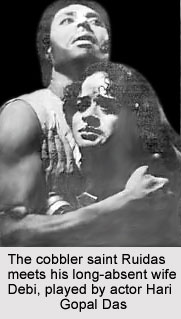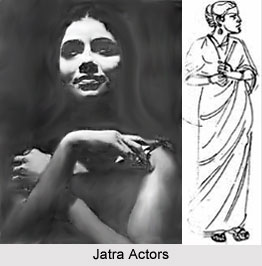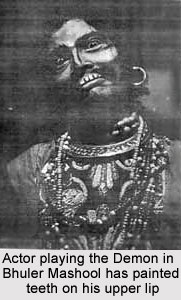 Actors in Jatra possess a sense of speech delivery and composition, and are greatly aware of the four sided audience and also sturdily elegant from all angels. There is flamboyance, action and speed. Sharp turns in mood, unexpected flares and sudden drops in sadness are carefully underlined by the musical team. Drums thump, clatter and rumble. The flute and trumpet player weaves a tapestry of notes that go with the occasion. The concept of background music, which came into the Bengali cinema in late 1930s, had long been a crucial part of Jatra. In Jatra, unlike in other form of folk drama, the singing is performed by actors and not by musicians. Various folk dramas in India like Yakshagana, Veedhi-natakam and Tamasha there is a great deal of dancing involved, hence, actors are out of breath and must be represented by the singing chorus. And there is also abhinaya which is expressive miming, and requires the singer to tell the story and comment. Presently in Jatra, the purpose of singing voices or chorus has been suspended.
Actors in Jatra possess a sense of speech delivery and composition, and are greatly aware of the four sided audience and also sturdily elegant from all angels. There is flamboyance, action and speed. Sharp turns in mood, unexpected flares and sudden drops in sadness are carefully underlined by the musical team. Drums thump, clatter and rumble. The flute and trumpet player weaves a tapestry of notes that go with the occasion. The concept of background music, which came into the Bengali cinema in late 1930s, had long been a crucial part of Jatra. In Jatra, unlike in other form of folk drama, the singing is performed by actors and not by musicians. Various folk dramas in India like Yakshagana, Veedhi-natakam and Tamasha there is a great deal of dancing involved, hence, actors are out of breath and must be represented by the singing chorus. And there is also abhinaya which is expressive miming, and requires the singer to tell the story and comment. Presently in Jatra, the purpose of singing voices or chorus has been suspended.
Make Up for Actors in Jatra
The make up is done, in the dressing room, by the actor himself. The dressing is a thatched enclosure which is three times as large as the stage where actors sit in a row cross legged with their make up kits. Shinning garments, laced tunics, silken saris and wigs of various shapes and colours hang on the clothes line. The figure of god or goddess, mainly Lord Krishna or Goddess Durga is present, lighted by small earthen lamp fed by ghee. For make up, the actors take help of white lead, amber grease, and lamp soot to give an oily sheen to the face. Demons, brutal generals and villains have intricate designs. Red streaks, Black stripes, crisscross lines and white knobs transform the actor into a fiendish character. The exterior of the actor is so unreal, and that makes audiences conscious of the presence of theatrical reality. The make up is applied in a very cleaver manner.
Social Class of Actors in Jatra
 The actors in Jatra come from various strata of society - fishermen, clerks, farmers, laborers, peddlers, middle-class businessmen. Jatra, in this respect, is unlike the folk theater of Bhavai, Therukoothu, Tamasha and Raslila where actors are confined to special castes. Conventionally, in Jatra, males have dominated the scenes. They play young heroes, dangerous villains; comic fools, Vivek (conscience) and some even specialize in female roles. Ladies have become a part of Jatra much later. The concept of men playing the role of women is common in Asian Theatres.
The actors in Jatra come from various strata of society - fishermen, clerks, farmers, laborers, peddlers, middle-class businessmen. Jatra, in this respect, is unlike the folk theater of Bhavai, Therukoothu, Tamasha and Raslila where actors are confined to special castes. Conventionally, in Jatra, males have dominated the scenes. They play young heroes, dangerous villains; comic fools, Vivek (conscience) and some even specialize in female roles. Ladies have become a part of Jatra much later. The concept of men playing the role of women is common in Asian Theatres.
As a result of revolutionary changes, and on popular demand from audiences, females have been incorporated in Jatra so play the roles of ladies. However there are practical problems that arise- a female voice does not reach a crowd of four thousand spectators. Whereas, the male playing role of woman is specially trained to speak in falsetto without sounding harsh, so in some jatra groups in West Bengal that has mixed casts with leading lady also played by male.
Popular Actors in Jatra
Hari Gopal Das, was arguably the best emotional "actress." In several roles of woman he has impressed the crowd, make them smile and cry at the same time. He was a natural actor with huge amount of experience in the field. Most of the actors who play the female roles in jatra add the suffix Rani to their name, which helps to distinguish themselves as female artists. These actors lead a completely normal life. They are married and have a family.
 One of the celebrated, well known and highly paid actors of jatra world has been Phani Bhushan Motilal, also known as Chhota Phani (younger Phani). He started out as a dancer in a chorus, and in other side roles, and made it to the leading bracket of jatra. He played many roles in his lifetimes like Siraj-Ud-Daula and other roles from Mahabharata. His popularity was tremendous.
One of the celebrated, well known and highly paid actors of jatra world has been Phani Bhushan Motilal, also known as Chhota Phani (younger Phani). He started out as a dancer in a chorus, and in other side roles, and made it to the leading bracket of jatra. He played many roles in his lifetimes like Siraj-Ud-Daula and other roles from Mahabharata. His popularity was tremendous.
Phani is a famous name in the Jatra circuit. Barring from the two main stream Phanis, Bara and Chhota (Big and Small) there are ten more Phanis at least, all convincingly eminent. The one in the Natta Company is Phani Bhattacharya, who plays the Queen Mother in Petitier Bhagawan.
Bara Phani Bhushan Bidyabinod, a versatile and talented actor, is comfortable in many roles. He can play the old saint, the young king, the sly servant, the vicious landlord, or the noble father with equal ease and grace. And it is because of this reason some people consider him to be a veteran Jatra actor.
Some of the popular actors started career in Jatra as amateur players. Among them, Ahindra Chowdhury; the late Teenakauri Mukherjee; the late Chhabi Biswas; Jauhar Ganguli; the late Phani Roy, alternated between the films and the Jatra; and the stage and film actor Nitish Mukherjee. Actor in Jatra who has experienced the challenge, the vitality, and the openness will always long to have the experience again.




















